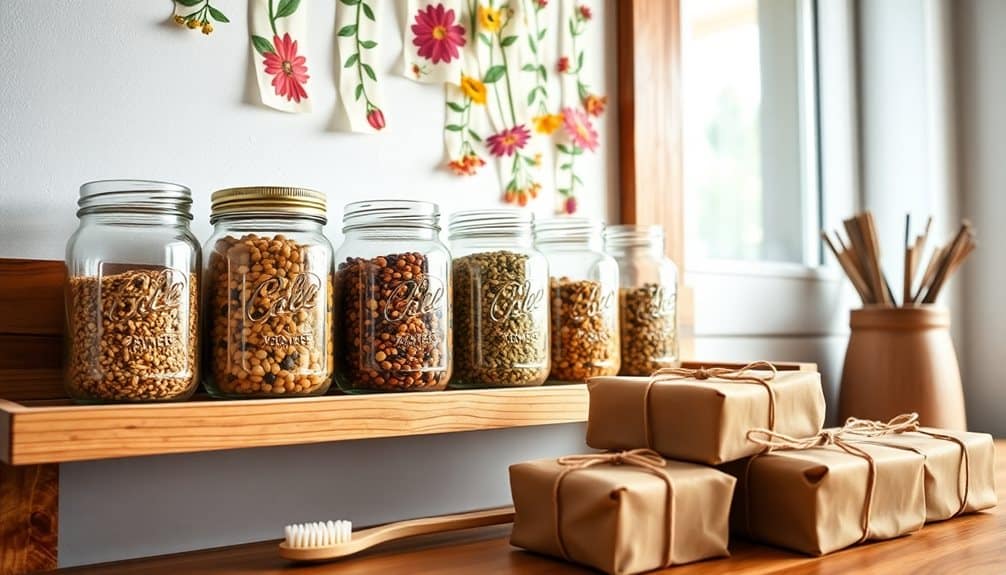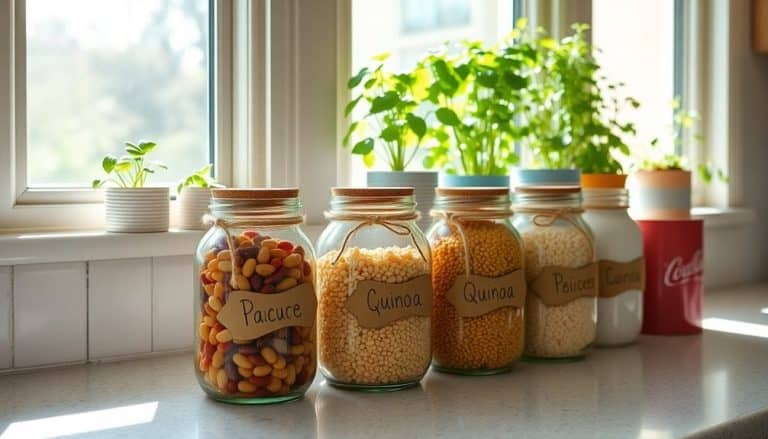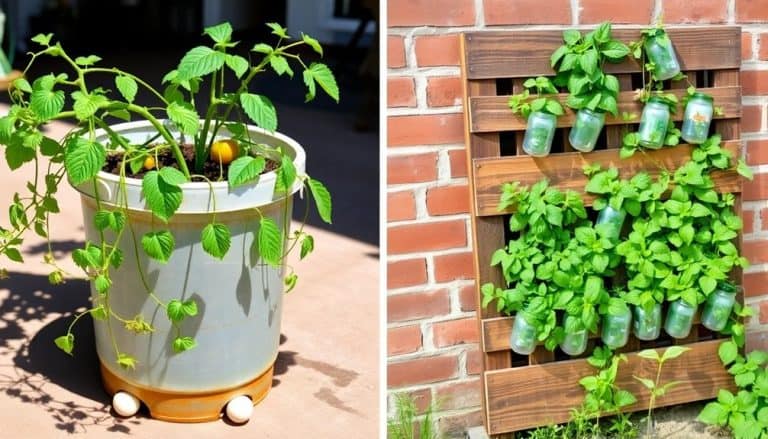This website contains affiliate links. Some products are gifted by the brand to test. As an Amazon Associate, I earn from qualifying purchases. The content on this website was created with the help of AI.
Transform your everyday waste into practical solutions with these five budget-friendly DIY projects. You’ll save money and reduce your environmental impact by turning old t-shirts into sturdy grocery bags, creating natural cleaning solutions from pantry staples, and making reusable beeswax food wraps to replace plastic wrap. Don’t toss those coffee grounds – they make excellent body scrubs when mixed with coconut oil. You can even start a kitchen scrap garden to regrow produce from vegetable leftovers. These simple projects will help you embrace a more sustainable lifestyle while keeping your wallet happy. Let’s explore each eco-friendly creation in detail.
Key Takeaways
- Transform old t-shirts into reusable grocery bags by cutting off sleeves and sewing the bottom hem for durable shopping alternatives.
- Make natural cleaning solutions using vinegar, baking soda, and citrus peels to eliminate harmful chemicals and reduce plastic waste.
- Create beeswax food wraps from cotton fabric and natural ingredients as a sustainable alternative to single-use plastic wrap.
- Convert used coffee grounds into body scrubs with coconut oil and brown sugar for natural skincare products.
- Start a kitchen scrap garden by regrowing vegetables from food waste to reduce grocery costs and minimize organic waste.
T-Shirt Grocery Bags
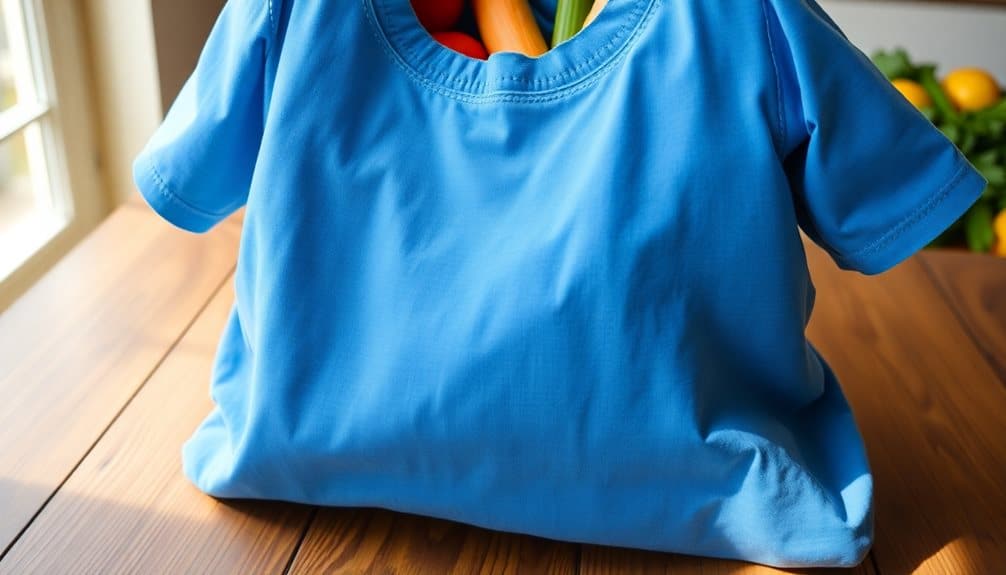
Transform your old t-shirts into durable, washable grocery bags instead of throwing them away. This simple DIY project requires minimal sewing skills and helps reduce plastic waste while giving new life to worn clothing. You’ll need scissors, a t-shirt, and either a sewing machine or needle and thread.
Start by laying your t-shirt flat and cut off the sleeves along the seams. Then remove the neckline by cutting a wider, U-shaped opening. Turn the shirt inside out and sew the bottom hem shut with a double stitch for extra strength. If you don’t have a sewing machine, use a tight blanket stitch.
To reinforce your bag, add a box stitch to the bottom corners. Fold the bottom corners into triangles and sew across them about 2-3 inches from the point. This creates a flat bottom that helps your bag stand upright when full. Turn the shirt right side out, and you’ve got a stretchy, washable grocery bag that can hold up to 25 pounds. Make several bags at once to keep in your car or by your door for shopping trips.
Natural Cleaning Solutions
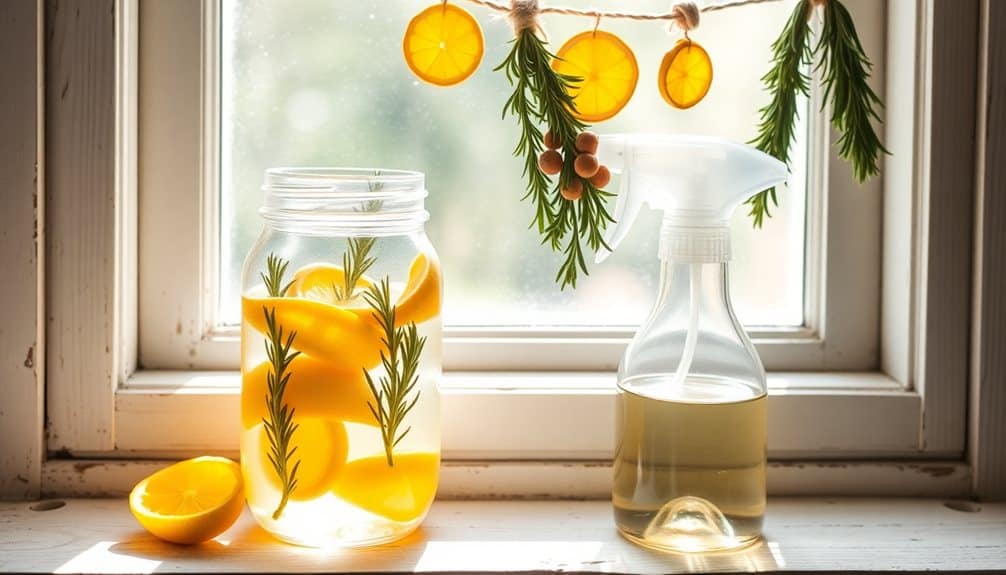
Making your own cleaning products is another powerful way to reduce household waste while avoiding harsh chemicals. You’ll need just a few basic ingredients like white vinegar, baking soda, citrus peels, and essential oils to create effective cleaners for every room in your home. These natural alternatives work just as well as commercial products but won’t harm the environment or your health.
Start with an all-purpose cleaner by combining equal parts water and white vinegar in a reusable spray bottle. Add citrus peels and let them infuse for two weeks to create a naturally scented solution. For bathroom surfaces, mix baking soda with just enough water to form a paste that’ll tackle tough grime and mineral buildup. You can also create a powerful drain cleaner by pouring baking soda down the drain, followed by vinegar, then hot water.
Store your homemade cleaners in glass bottles or jars you’ve saved from other products. Label each container clearly with the contents and date. You’ll find that these simple solutions not only save money but also eliminate the need for dozens of single-use plastic cleaning bottles.
Beeswax Food Wraps
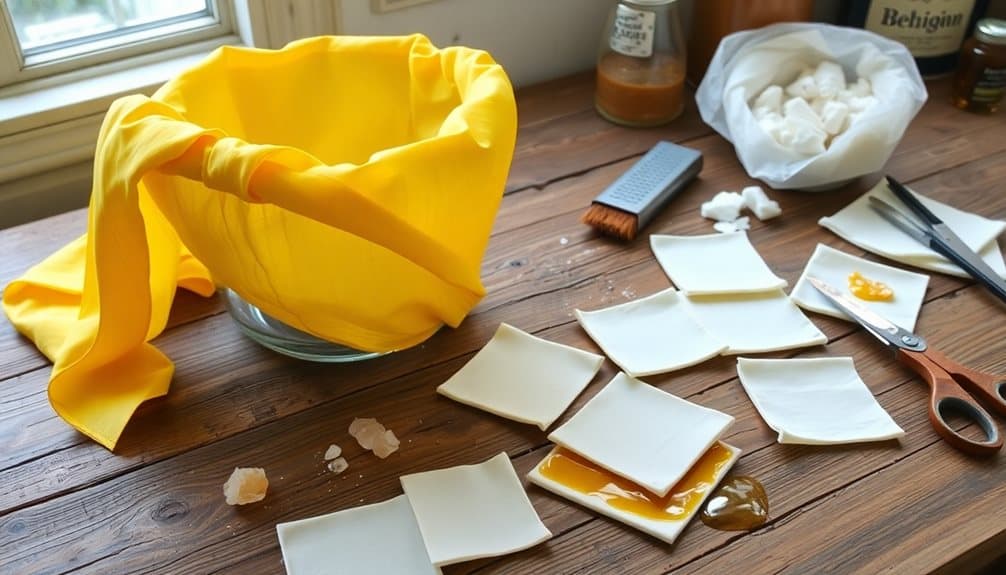
Beeswax food wraps stand out as an elegant solution to replace single-use plastic wrap and bags in your kitchen. You’ll find these reusable wraps are not only eco-friendly but also cost-effective when you make them yourself. They’re perfect for covering bowls, wrapping cheese, sandwiches, and fresh produce.
To create your own wraps, you’ll need 100% cotton fabric, beeswax pellets, pine resin, and jojoba oil. Cut your fabric into desired sizes, then sprinkle the beeswax mixture evenly across the surface. Place the fabric between two sheets of parchment paper and iron until the wax melts completely. Once cool, your wraps are ready to use.
You can maintain your wraps by washing them in cool water with mild soap, then air-drying them completely. They’ll typically last 6-12 months with proper care. When they begin to lose their cling, you can refresh them by reapplying a thin layer of beeswax mixture. Once they’ve reached the end of their life cycle, simply compost them, knowing you’ve kept countless plastic wraps out of landfills. Instead of traditional plastic wrap alternatives, consider using coco coir products as sustainable composting material when disposing of your used beeswax wraps.
Coffee Ground Scrubs

Every morning’s spent coffee grounds can become a luxurious body scrub, turning a common kitchen waste into an all-natural beauty product. You’ll find that coffee grounds work as an excellent exfoliant while providing a gentle massage effect that helps stimulate blood flow and potentially reduce the appearance of cellulite.
To create your coffee scrub, collect your used grounds and let them dry completely to prevent mold growth. Mix one cup of grounds with half a cup of coconut oil or sweet almond oil, and add a quarter cup of brown sugar for extra scrubbing power. You can enhance your scrub with five drops of vanilla essential oil or two tablespoons of cocoa powder for an energizing mocha scent.
Store your DIY scrub in an airtight glass jar and use it within two months. When applying, massage the scrub in circular motions on damp skin, focusing on rough areas like elbows and feet. You’ll notice your skin feels softer and looks more radiant. Remember to use this scrub in the shower with a drain catcher to prevent coffee grounds from clogging your pipes. Like activated charcoal filters, coffee grounds excel at absorbing and neutralizing unwanted odors, making them perfect for beauty treatments.
Kitchen Scrap Garden

While coffee grounds offer beauty benefits in the bathroom, your kitchen scraps can create an abundant indoor garden. Instead of tossing vegetable leftovers into the trash, you’ll find that many kitchen scraps can regrow into fresh produce. Start with easy-to-grow items like green onions, lettuce, and celery by placing their base sections in shallow water.
You can regrow herbs by saving stems with healthy leaves and placing them in water until roots develop. Transfer them to soil-filled containers once roots are established. For more ambitious projects, try sprouting avocado pits by suspending them over water using toothpicks, or plant sweet potato slips in containers after they’ve developed shoots.
Keep your scrap garden thriving by changing the water every few days and providing adequate sunlight. Place containers near a sunny window or under grow lights. Remember to transfer water-started plants to soil once they’ve developed strong roots. You’ll reduce food waste while enjoying fresh, homegrown produce year-round. Plus, you’ll save money on groceries and create a sustainable source of food right in your kitchen. Similar to adjustable hive stands, maintaining proper spacing between plants ensures adequate airflow and reduces disease transmission.
Frequently Asked Questions
How Long Should I Soak My DIY Cleaning Solutions Before Using Them?
For vinegar-based cleaning solutions, let them sit for 30-60 minutes before use. You’ll want to soak citrus peels in vinegar for 2-3 weeks to create potent cleaners. If you’re using baking soda paste, 10-15 minutes is sufficient. For tough stains, let your solution sit overnight. Remember to test any DIY cleaner on a small area first to guarantee it won’t damage your surfaces.
Can I Use Synthetic Fabrics Instead of Cotton for Zero-Waste Projects?
While you can use synthetic fabrics, they’re not the best choice for zero-waste projects since they release microplastics when washed and don’t biodegrade. Instead, opt for natural fibers like cotton, hemp, or linen – they’re biodegradable and more sustainable. If you already have synthetic fabrics, repurpose them rather than buying new ones. This helps reduce waste and extends their useful life.
What Zero-Waste Alternatives Are Safe for People With Bee Allergies?
Mindfully managing allergies means you’ll need bee-free alternatives for your zero-waste journey. You can use agave nectar instead of honey, craft your own beeswax-free food wraps with soy or candelilla wax, and choose vegan lip balms. For pollinator-friendly gardens, plant self-pollinating vegetables and fruits. When shopping, look for products with carnauba wax rather than beeswax, and select bamboo-based personal care items.
Are Homemade Zero-Waste Products Safe to Use Around Pets?
You’ll need to carefully choose ingredients when making zero-waste products around pets. Avoid essential oils like tea tree, eucalyptus, and citrus, which can harm cats and dogs. Keep cleaning solutions out of reach and guarantee proper ventilation. Stick to pet-safe ingredients like vinegar, baking soda, and unscented castile soap. Always research specific ingredients before use, as pets can be sensitive to common natural components.
How Much Money Can I Typically Save Annually With Zero-Waste DIY Projects?
You can save $1,000-3,000 annually by making your own cleaning products, personal care items, and household essentials. DIY laundry detergent alone saves about $200 yearly, while homemade cleaners cut costs by $300-400. Creating your own beauty products, like moisturizers and scrubs, saves another $500. You’ll save even more by switching to reusable alternatives like cloth napkins, DIY beeswax wraps, and washable cleaning cloths.

